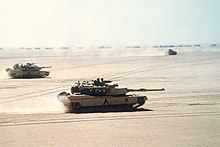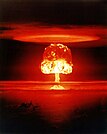
A | B | C | D | E | F | G | H | CH | I | J | K | L | M | N | O | P | Q | R | S | T | U | V | W | X | Y | Z | 0 | 1 | 2 | 3 | 4 | 5 | 6 | 7 | 8 | 9
Ancient warfare: Stele of the Vultures, c. 2500 BCE
Medieval warfare: Battle of Hastings, 1066
Early modern warfare: Retreat from Moscow, 1812
Industrial age warfare: Battle of the Somme, 1916
Modern warfare: Normandy landings, 1944
Nuclear warfare: Nuclear weapon test, 1954
| Part of a series on |
| War Outline |
|---|
 |
War is an intense armed conflict[a] between states, governments, societies, or paramilitary groups such as mercenaries, insurgents, and militias.[2] It is generally characterized by extreme violence, destruction, and mortality, using regular or irregular military forces. Warfare refers to the common activities and characteristics of types of war, or of wars in general.[3] Total war is warfare that is not restricted to purely legitimate military targets, and can result in massive civilian or other non-combatant suffering and casualties.
While some war studies scholars consider war a universal and ancestral aspect of human nature,[4] others argue it is a result of specific socio-cultural, economic, or ecological circumstances.[5]
Etymology

The English word war derives from the 11th-century Old English words wyrre and werre, from Old French werre (also guerre as in modern French), in turn from the Frankish *werra, ultimately deriving from the Proto-Germanic *werzō 'mixture, confusion'. The word is related to the Old Saxon werran, Old High German werran, and the modern German verwirren, meaning 'to confuse, to perplex, to bring into confusion'.[6]
History


The earliest evidence of prehistoric warfare is a Mesolithic cemetery in Jebel Sahaba, which has been determined to be about 13,400 years old.[7] About forty-five percent of the skeletons there displayed signs of violent death, specifically traumatic bone lesions.[8]
In War Before Civilization, Lawrence H. Keeley, a professor at the University of Illinois, says approximately 90–95% of known societies throughout history engaged in at least occasional warfare,[9] and many fought constantly.[10] Keeley describes several styles of primitive combat such as small raids, large raids, and massacres. All of these forms of warfare were used by primitive societies, a finding supported by other researchers.[11] Keeley explains that early war raids were not well organized, as the participants did not have any formal training. Scarcity of resources meant defensive works were not a cost-effective way to protect the society against enemy raids.[12]
William Rubinstein wrote "Pre-literate societies, even those organized in a relatively advanced way, were renowned for their studied cruelty.'"[13] Since the rise of the state some 5,000 years ago,[14] military activity has continued over much of the globe. The invention of gunpowder, and its eventual use in warfare, together with the acceleration of technological advances have fomented major changes to war itself.

In Western Europe, since the late 18th century, more than 150 conflicts and about 600 battles have taken place.[15] During the 20th century, war resulted in a dramatic intensification of the pace of social changes, and was a crucial catalyst for the growth of left-wing politics.[16]

In 1947, in view of the rapidly increasingly destructive consequences of modern warfare, and with a particular concern for the consequences and costs of the newly developed atom bomb, Albert Einstein famously stated, "I know not with what weapons World War III will be fought, but World War IV will be fought with sticks and stones."[17]
Mao Zedong urged the socialist camp not to fear nuclear war with the United States since, even if "half of mankind died, the other half would remain while imperialism would be razed to the ground and the whole world would become socialist."[18]
A distinctive feature of war since 1945 is that combat has largely been a matter of civil wars and insurgencies.[19] The major exceptions were the Korean War, the Indo-Pakistani War of 1971, the Iran–Iraq War, the Gulf War, the Eritrean–Ethiopian War, and the Russo-Ukrainian War.

The Human Security Report 2005 documented a significant decline in the number and severity of armed conflicts since the end of the Cold War in the early 1990s. However, the evidence examined in the 2008 edition of the Center for International Development and Conflict Management's "Peace and Conflict" study indicated the overall decline in conflicts had stalled.[20]
Types of warfare
- Asymmetric warfare is the methods used in conflicts between belligerents of drastically different levels of military capability or size.[21]
- Biological warfare, or germ warfare, is the use of biological infectious agents or toxins such as bacteria, viruses, and fungi against people, plants, or animals. This can be conducted through sophisticated technologies, like cluster munitions,[22] or with rudimentary techniques like catapulting an infected corpse behind enemy lines,[23] and can include weaponized or non-weaponized pathogens.
- Chemical warfare involves the use of weaponized chemicals in combat. Poison gas as a chemical weapon was principally used during World War I, and resulted in over a million estimated casualties, including more than 100,000 civilians.[24]
- Cold warfare is an intense international rivalry without direct military conflict, but with a sustained threat of it, including high levels of military preparations, expenditures, and development, and may involve active conflicts by indirect means, such as economic warfare, political warfare, covert operations, espionage, cyberwarfare, or proxy wars.
- Conventional warfare is a form of warfare between states in which nuclear, biological, or chemical weapons are not used or see limited deployment.
- Cyberwarfare involves the actions by a nation-state or international organization to attack and attempt to damage another nation's information systems.
- Insurgency is a rebellion against authority, when those taking part in the rebellion are not recognized as belligerents (lawful combatants). An insurgency can be fought via counterinsurgency, and may also be opposed by measures to protect the population, and by political and economic actions of various kinds aimed at undermining the insurgents' claims against the incumbent regime.
- Information warfare is the application of destructive force on a large scale against information assets and systems, against the computers and networks that support the four critical infrastructures (the power grid, communications, financial, and transportation).[25]
- Nuclear warfare is warfare in which nuclear weapons are the primary, or a major, method of achieving capitulation.
- Total war is warfare by any means possible, disregarding the laws of war, placing no limits on legitimate military targets, using weapons and tactics resulting in significant civilian casualties, or demanding a war effort requiring significant sacrifices by the friendly civilian population.
- Unconventional warfare, the opposite of conventional warfare, is an attempt to achieve military victory through acquiescence, capitulation, or clandestine support for one side of an existing conflict.
Aims

Entities contemplating going to war and entities considering whether to end a war may formulate war aims as an evaluation/propaganda tool. War aims may stand as a proxy for national-military resolve.[26]
Definition
Fried defines war aims as "the desired territorial, economic, military or other benefits expected following successful conclusion of a war".[27]
Classification
Tangible/intangible aims:
- Tangible war aims may involve (for example) the acquisition of territory (as in the German goal of Lebensraum in the first half of the 20th century) or the recognition of economic concessions (as in the Anglo-Dutch Wars).
- Intangible war aims – like the accumulation of credibility or reputation[28] – may have more tangible expression ("conquest restores prestige, annexation increases power").[29]
Explicit/implicit aims:
- Explicit war aims may involve published policy decisions.
- Implicit war aims[30] can take the form of minutes of discussion, memoranda and instructions.[31]
Positive/negative aims:
Zdroj:https://en.wikipedia.org?pojem=Warfare
Text je dostupný za podmienok Creative Commons Attribution/Share-Alike License 3.0 Unported; prípadne za ďalších podmienok. Podrobnejšie informácie nájdete na stránke Podmienky použitia.
Antropológia
Aplikované vedy
Bibliometria
Dejiny vedy
Encyklopédie
Filozofia vedy
Forenzné vedy
Humanitné vedy
Knižničná veda
Kryogenika
Kryptológia
Kulturológia
Literárna veda
Medzidisciplinárne oblasti
Metódy kvantitatívnej analýzy
Metavedy
Metodika
Text je dostupný za podmienok Creative
Commons Attribution/Share-Alike License 3.0 Unported; prípadne za ďalších
podmienok.
Podrobnejšie informácie nájdete na stránke Podmienky
použitia.
www.astronomia.sk | www.biologia.sk | www.botanika.sk | www.dejiny.sk | www.economy.sk | www.elektrotechnika.sk | www.estetika.sk | www.farmakologia.sk | www.filozofia.sk | Fyzika | www.futurologia.sk | www.genetika.sk | www.chemia.sk | www.lingvistika.sk | www.politologia.sk | www.psychologia.sk | www.sexuologia.sk | www.sociologia.sk | www.veda.sk I www.zoologia.sk






